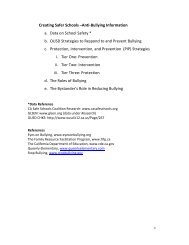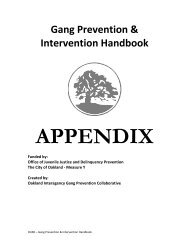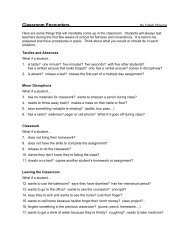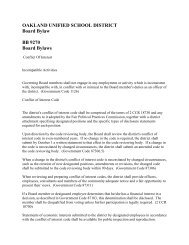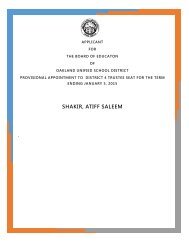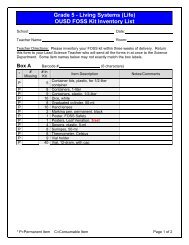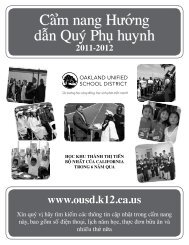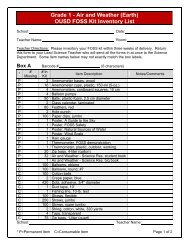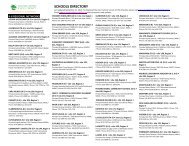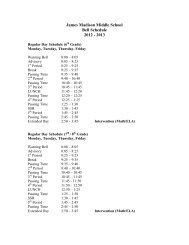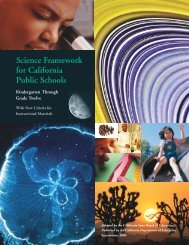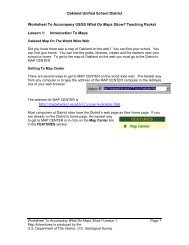Oakland Unified School District Case Study
Oakland Unified School District Case Study
Oakland Unified School District Case Study
Create successful ePaper yourself
Turn your PDF publications into a flip-book with our unique Google optimized e-Paper software.
Table 1: AWE Enrollment Trends<br />
Year<br />
<strong>School</strong> Size<br />
% African<br />
American<br />
% Latino<br />
% English<br />
language<br />
learner<br />
% Free and<br />
reduced<br />
lunch<br />
2007-08 246 19% 75% 70% 91%<br />
2006-07 250 17% 75% 60% 92%<br />
2005-06 258 22% 71% 56% 77%<br />
2004-05 241 25% 71% 57% n/a<br />
2003-04 251 28% 69% 60% 87%<br />
Source: http://data1.cde.ca.gov/dataquest/ accessed 11-18-2008<br />
est API score. Given that the California<br />
Standards Tests (CST) are in English,<br />
AWE’s growth is even more notable. Many<br />
school leaders attribute this recent increase<br />
in scores to changes in the school’s curriculum,<br />
assessments, and instructional<br />
practices.<br />
As a result of the somewhat flat scores<br />
over the preceding 3 years, school<br />
leaders had made important changes<br />
in their instructional program aimed at<br />
reaching their goal of an 800 API score.<br />
One important change in 2007-08 was<br />
the development of interim assessments<br />
for English language arts (ELA) based<br />
on the New Leaders for New <strong>School</strong>s 6<br />
assessments. The interim assessments in<br />
ELA were also more closely aligned to<br />
the CST providing teachers better data<br />
on areas where student learning is strong,<br />
areas where students are struggling, and<br />
areas where more or different classroom<br />
instruction may be needed. Specifically,<br />
the ELA interim assessment results<br />
showed that students were not receiving<br />
enough active learning opportunities<br />
to independently understand what they<br />
were reading. This information pointed<br />
the teachers toward making changes<br />
in their classroom teaching practice as<br />
the year progressed that fostered student<br />
engagement.<br />
Another important change was the implementation<br />
of the Si Swun math program. 7<br />
The Si Swun math program provided the<br />
school with assessments better aligned to<br />
the end-of-year CST in math, and was more<br />
closely aligned to the school’s active learning<br />
philosophy. Both Si Swun and the New<br />
Leaders assessments are key components of<br />
the district’s move toward standards-based<br />
classroom assessments, as 20 schools will<br />
implement the Si Swun program in 2008-<br />
09, and 11 schools piloted the New Leaders<br />
assessments in 2007-08. The initial scores<br />
on the ELA and math assessments show<br />
students making significant progress over<br />
the course of the year (see Figures 1 and 2,<br />
page 4).<br />
The 2008-09 school year is the first year<br />
that these assessments were used at the<br />
school, and the final administration of the<br />
tests correlated almost exactly with the CST<br />
scores. On the ELA assessment, 43% of<br />
students were proficient or advanced, compared<br />
to 44% on the CST; on the Si Swun<br />
math assessment, 67% were proficient or<br />
advanced compared to 65% on the CST<br />
math test.<br />
OUSD <strong>Case</strong> <strong>Study</strong>: ACORN Woodland Elementary 3



